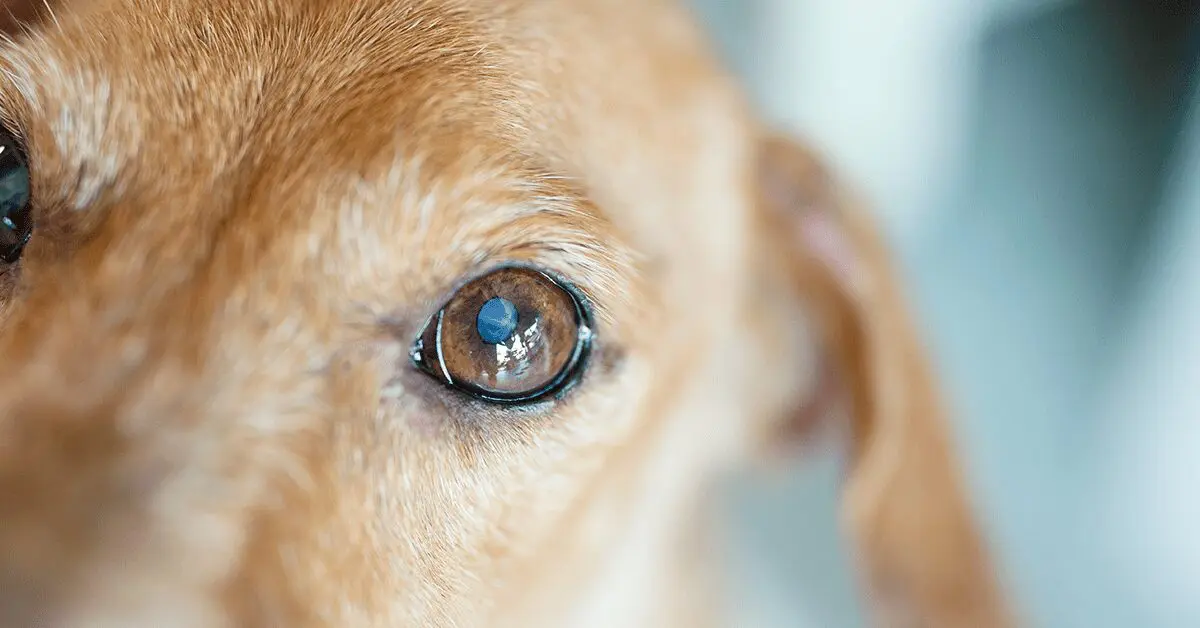Key points
- Canine cataracts can range from minor to severe cases, depending on the disease’s cause and stage.
- Cataracts are a progressive disease that can get worse over time if left untreated.
- While there is no cure for cataracts, surgery can remove the cataract and return vision to the affected eye.
Have you noticed cloudiness in your dog’s eyes recently? Has your dog been experiencing an increase in clumsiness and what might be considered vision loss? Cataracts could be to blame.
What are cataracts?
Just like humans, dogs can develop cataracts: a progressive disease that causes the clouding of a normally clear eye lens. Called nuclear sclerosis, this clouding occurs when proteins in the eye break down and create opaque cloudiness that impairs the passage of light and images to the retina.
In most cases, cataracts develop slowly over the course of years as your dog ages, but in certain cases – in a dog with diabetes, for example – cataracts can develop quickly. If left untreated, cataracts can lead to infection, glaucoma, and eventual blindness.
While you might think cataracts only affect older dogs, young dogs and puppies can also develop cataracts. The speed at which cataracts develop can vary depending on the specific situation.
Symptoms
The most common sign that your dog may be developing cataracts is visible bluish cloudiness over the affected eye and increased clumsiness (often a result of vision loss).
Depending on the size of the cataracts, your dog may or may not experience vision loss. If the cataracts only occupy 30% of the total lens area, your dog likely won’t experience significantly diminished vision. If the cataracts occupy 60% of the lens area, your dog will experience vision loss. If the cataracts occupy 100% of the lens area, your dog will experience blindness in the affected eyes and will only be able to see changes in light.
Chronic cataracts can be very painful for your dog. As the lens deteriorates, it can cause uveitis inflammation or glaucoma – and your pup’s affected eye may need to be removed if not treated. That’s why it’s so important to spot signs of cataracts before the condition has reached a point of no return.
There are four stages of cataracts in dogs:
- Incipient cataracts: This is the smallest stage of cataracts. At this point, the cataracts appear as a tiny cloud of opaque coloring in the dog’s eye. Incipient cataracts do not require surgery.
- Immature cataracts: This is the classification for cataracts that cover between 15% to 99% of the lens. The affected eyes can still see, but vision loss occurs after 60% cataracts coverage.
- Mature cataracts: This is the classification for cataracts that cover 100% of the lens. In this case, the eye can only see changes in light and it’s recommended the dog has surgery.
- Hypermature cataracts: This is the most advanced stage of cataracts. At this stage, the lens of the eye wrinkles and the cataract solidifies and shrinks. Depending on the severity of the cataracts, surgery may not be an option.
“Depending on the size, signs of cataracts in dogs can range from nothing at all to complete blindness,” says Dr. Chyrle Bonk (DVM), veterinarian at Senior Tail Waggers. “Small cataracts might not cause any vision loss and may be too small to be seen without magnification. Larger cataracts may cloud vision, causing a dog to bump into things or stumble over objects. You may also be able to see a dark cloudiness in the eyeball.”
Causes
There are a few different factors that can lead to the development of cataracts in dogs. Some of the most common causes of cataracts in dogs are:
- Genetics: Some dog breeds have a higher chance of developing cataracts due to gene mutations. Over 100 dog breeds are known to be affected by hereditary cataracts.
- Age: As a dog gets older, they can develop vision-related issues such as cataracts.
- Eye inflammation: Injuries or illnesses that affect the eye, such as inflammation, can cause damage that leads to the development of cataracts.
- Diabetes: Dogs can develop diabetes and what is called diabetic cataracts. Due to the increased blood glucose levels, the sugars within the lens of the dog’s eyes accumulate and cause cataracts. Diabetic dogs will commonly develop cataracts quickly, within a year of being diagnosed. Cataracts caused by diabetes can be treated and even reversed with careful management of your dog’s diet and insulin. The application of eye drops may also be necessary.
Some dog breeds that are known to commonly develop cataracts are:
- Poodle
- Golden retriever
- Labrador retriever
- Cocker spaniel
- Huskies
- Boston terrier
- Schnauzer
Diagnosis
If you’re concerned that your dog might be developing cataracts, we recommend taking your pup to the vet to be examined as soon as possible.
Your vet will ask about your dog’s medical history and any prior health conditions or illnesses. They will then perform a physical exam using a bright light and magnifying lens to thoroughly examine your dog’s eyes for any signs of cataract development, inflammation, or glaucoma.
If warranted, your vet might decide to perform diagnostic testing – checking your dog’s blood count, intraocular pressure, urinalysis, and biochemistry profile to make sure your dog isn’t suffering from an illness such as diabetes. If your vet is unable to perform the diagnostic testing on hand, they may refer you to a board-certified veterinary ophthalmologist for more comprehensive testing.
Veterinary ophthalmologists can also surgically remove cataracts. If you’ve confirmed that your dog has canine cataracts and your vet has recommended cataract-removal surgery, you’ll need a referral for a veterinary ophthalmologist.
Treatment
Unfortunately, at this time, there are no medical treatments that are able to cure cataracts. The only available treatment option is cataract removal through a type of surgery called canine phacoemulsification, which has a reported success rate of around 90% to 95%
During phacoemulsification surgery, a veterinary ophthalmologist makes small incisions in the cornea of the affected eye to access the lens capsule. They then use high-frequency vibrations known as ultrasound to break the lens into small fragments which are then surgically removed from the eye. The lens is then replaced with an artificial lens and the cornea is sutured closed, restoring vision to the eye. It’s important to note that the more mature the cataract is, the more likely your pup is to experience postoperative complications. That’s why you should act quickly if surgery is your chosen path.
Cataracts caused by diabetes may be managed or even reversed through careful management of your dog’s diet and insulin. The application of eye drops may also be necessary. “Cataracts that are brought on by diabetes may be delayed or treated with eye drops,” explains Dr. Bonk.
Recovery and care
If you’ve decided to go through with cataract removal surgery, your dog will need to be carefully monitored through the recovery process. Dogs usually stay in the hospital for 2 to 3 days so the doctor can oversee the initial healing process, performing postoperative examinations and initial monitoring.
Once your pup is discharged from the hospital, you’ll need to keep a close eye on them through the healing process, administering a variety of anti-inflammatory eye drops, oral medications, and supplements throughout the day.
Your dog will also require frequent follow-up examinations to make sure the eye is healing correctly and monitor for any postoperative complications such as infection, protracted intraocular inflammation, corneal ulcers, or retinal detachment.
Once healed, your dog will be back to their normal, happy self – however, they’ll still require routine examinations for the rest of their life to ensure their eyes are healthy.
Prevention
While cataracts caused by diabetes can be managed and treated with a carefully managed diet and insulin intake, it’s generally impossible to prevent the development of hereditary cataracts. The best thing you can do as a responsible dog owner is to regularly take your pup to the vet to get checked. Managing these conditions and regularly checking your dog’s eyes can help preserve their vision.
What to expect at the vet’s office
Vets know how scary it is for pet owners to bring their dog in for something as serious as cataracts. Your local vet will be able to help you understand your fur baby’s condition and answer any questions you may have. After examining your dog, the vet will help you work through your treatment options and determine the next steps.
The bottom line
If you suspect your dog may be developing cataracts or having vision problems, you should take them to your vet as soon as possible. While cataracts are not something to take lightly, your dog can still live a happy and healthy life with cataracts.
“Cataract development is often gradual, so even if a dog goes blind from them, it won’t happen overnight,” says Dr. Bonk. “This gives them plenty of time to adjust, and most dogs actually do well being blind as long as things aren’t abruptly changed on them. This means no moving the furniture or sudden changes in their environment. Make sure to always keep a blind dog on a leash when they’re not in an enclosed area.”
FAQ
Does pet insurance cover cataract surgery in dogs?
Pet insurance can help you afford the cost of eligible vet bills if your dog gets sick or hurt, and this may include cataract surgery. However, if your dog is diagnosed with or treated for cataracts before you purchase a pet insurance plan, it is considered a pre-existing condition. Most plans and providers do not cover treatment for pre-existing conditions.
Are cataracts painful for dogs?
Cataracts can be very painful for your dog. As the lens deteriorates, it can cause inflammation or other unpleasant medical complications. If left untreated, eyes afflicted with cataracts may need to be removed – so visiting the vet early on is essential.
Is there a cure for cataracts in dogs?
Unfortunately, at this time, there are no medical treatments that are able to cure cataracts. Currently, the only treatment option available for canine cataracts is surgery.




